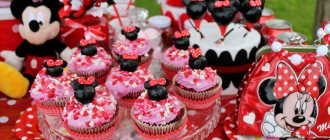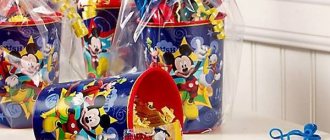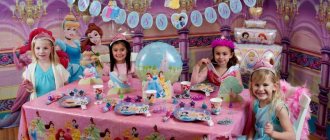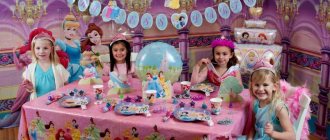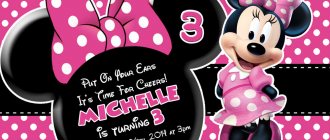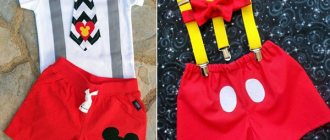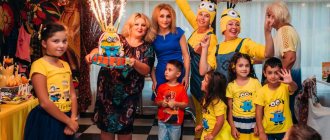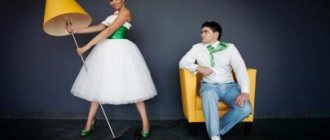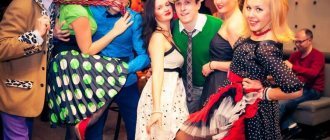Creator: Walt Disney
Occupation: cartoon character
Relationship status: Single
Minnie Mouse loves to sing, dance and dress beautifully - she has become famous throughout the world thanks to her polka dot dresses and pumps. And most of all, Minnie loves to spend time with her beloved Mickey.
Romantic, sweet and attentive, Minnie tirelessly takes care of her friends and pets. However, her kindness and gentle disposition can easily give way to anger if Minnie is faced with rudeness, narcissism or... disorder.
Appearance
She goes by the name "Minerva Mouse", in honor of the ancient Roman goddess Minerva.
Minnie Mouse first appeared in the 1928 animated short Airplane Crazy. During the first year, the character was voiced by Walt Disney himself.
In the town square in Fairytale Kingdom there is a statue of Roy Oliver Disney sitting on a bench next to Minnie Mouse.
On January 22, 2021, Minnie Mouse was awarded a star on the Hollywood Walk of Fame with the wording "For her roles in animated films, and for her outstanding influence on fashion since her debut appearance, in honor of the 90th anniversary."
Festive table
We decorate it in the chosen color scheme. A polka dot print, red and pink colors would be appropriate here. And to make it clear that our holiday is in the style of Minnie Mouse, we decorate black disposable plates with cute ears and napkins folded in the shape of a bow.
It is also advisable to choose black or pink cutlery, as well as napkins. We decorate the cutlery with Minnie figures or simply decorate it with a napkin folded in a bow.
The theme should also be present in the design of the dishes. Here are some options for serving snacks:
Appearance description
“Just imagine... He will enter the room; light will emanate from it. I'll hear music, he'll bring me flowers and sweep me off my feet! And I will know that he is the one who makes me laugh."
―Minnie dreamily fantasizes about her dream lover; giving an example of her romantic personality.
From the moment of her appearance, Minnie reflected the trends of the youth culture of the time, in particular, the love of the color red. Despite this, she was supposed to appear in blue and green outfits. In Iwerks's early black-and-white cartoons, she has a large rectangular underwear patch above her tail.
In 1940, Minnie's outfit was revised: the hat on her head was replaced by a large bow, and even small bows appeared on her shoes. Her eyes also became more distinct. Throughout the forties and fifties, her look was conservative. In everyday life, Minnie wears a red sundress and a red bow with white polka dots and yellow shoes. Minnie wore many swimsuits, but her most common and elegant one is a red two-piece swimsuit with a skirt and a red bow with white polka dots.
Personality
Minnie is cool, fun and feminine. She is filled to the brim with love and affection, sweet for almost everyone she encounters, and can usually see the beauty in most things. Minnie's kindness is sometimes exploited by other characters, but Minnie appreciates her good-natured spirit as it often brings happiness to others, which is something she strives to do regularly. she is quite empathetic in this regard, to the point that she will take someone else's problems and try to fix them herself, even if that someone may be her enemy.
Smart and sophisticated, Minnie often serves as the "voice of reason" among her friends, especially at the House of Mouse. Throughout the series, Minnie has repeatedly taken responsibility for troublesome situations, usually as a result of Mickey's inability to handle too much pressure despite being part owner of the club. This is so true that Minnie was especially offended when Mickey believed she couldn't cope with such a mundane task as walking through the basement of a club (a very large basement, of course). Minnie is capable, and even serving as a "damsel in distress" at the hands of the villainous Pete, Minnie would often take revenge if given the chance, thus helping Mickey in taking down the villain and saving the day in the Mickey Mouse series. Minnie would sometimes get into trouble, which Mickey would get into tried his best to save her - by the time he finds her, however, he learns that she was able to handle the situation on her own
However, Minnie is not without her weaknesses. She can be passive at times, which forces her to deal with an excessive amount of tomfoolery at the hands of her friends. She can also be extremely stubborn and does not take orders (or even advice) from anyone, always going by her own rules and doing things what she thinks is best. While this is a positive trait in that it makes her independent and confident, it also causes her to act rashly and obsessively, at least until she realizes what problems she has caused
Minnie is also outspoken when dealing with opponents. She has little tolerance for any kind of rudeness or bullying, especially when the bullying involves misogynistic and prejudiced viewpoints. And while she can be passive at times, Minnie also has her limits; she has lost her temper many times with Daisy for her diva attitude and Mickey for his occasional selfishness. Her aggression is also regularly shown when Mortimer Mouse is involved, as she will happily make a fool of a rodent for his constant stalking
Essentially, Minnie is a lover of life, nature, her friends, and most importantly, Mickey, who serves not only as her boyfriend, but also as her best friend. Because she believes in "true love" usually found in fairy tales, Minnie is quite dreamy and whimsical (as opposed to her more serious side), which she is quite unapologetic about.
Voice acting
Minnie was first voiced by Walt Disney, who was also the original voice of Mickey Mouse. Marjorie Ralston, a Disney actress, voiced her in a cartoon in 1929. She was then voiced by Marcelline Garner from 1929 to 1939. Then, from 1941 to 1942, and on the radio program The Mickey Mouse Theater of Air, she was voiced by Thelma Boardman. After this, from 1942 to 1952, Ruth Clifford provided the character's voice. Janet Waldo voiced Minnie in the 1974 Disneyland album performed by The Walt Disney Players. Currently, Russi Taylor has been voicing Minnie since 1986.
Mickey Mouse: toys
Mickey Mouse creator Walt Disney saw early on the many opportunities that came with selling his beloved mouse. To make Mickey more popular, already in 1929 the first products with his image appeared on sale - various student folders and other school supplies. Three years later, sales had grown so much that it was possible to create a separate company to produce and sell Mickey Mouse toys and accessories.
In January 1930, plush Mickey Mouse figures began to be produced in Los Angeles, and by the end of that decade there was virtually no product that was not emblazoned with an advertising image of Mickey (or Minnie), be it a jam jar, corsets, household items, or toys. , books and even jewelry. Mickey was omnipresent: in France, for example, he advertised the drink Fanta.
In the 70s and 80s, Mickey conquered the fashion field. It has become fashionable to wear clothes with the image of Mickey or one of his friends and relatives. Even now you can find such clothes in catalogs or children's specialized stores.
The modern assortment of toys from the Mickey Mouse and Friends series is impossible to describe. In addition to the good old plush figures, you will be pleased with various kinds of creativity kits, cars, bicycles, airplanes, electronic posters, walkie-talkie sets, transforming eggs, paintings, puzzles and much more.
Story
1928
In 1928, Walt Disney and Ub Iwerks created Mickey Mouse to replace his previous star, Oswald the Lucky Rabbit. But Mickey couldn't fill the void alone. In "Plane Crazy" on May 15, 1928, Minnie and Mickey fly the latest homemade flying machines. During which, Mickey repeatedly tries to romanticize Minnie, but she politely refuses these particular advances.
The next film with the participation of the couple was “Galloping on an Ostrich”. It was the second of their series to be produced, but only the third to be released on March 14, 1929. In it, Minnie was hired as a waitress and dancer at the "Cantina Argentina", a bar and restaurant set in " pampas" from Argentina. She performs tango for Mickey the Gaucho and Black Pete the Outlaw. Both flirt with her, but the latter intends to kidnap her, while the former obliges in rescuing the "damsel in distress" from the villain. All three characters acted like strangers being introduced to each other.
They appear together again in "Steamboat Willie", the third short to be produced, but released first on November 18, 1928. Pete was introduced as the captain of the steamboat, Mickey as a one-man crew and Minnie as their only passenger.
The commercial success of "Steamboat Willie" helped introduce Mickey and Minnie to audiences. Twelve more films starring Mickey were produced in 1929, but Minnie only starred in seven of them and was credited in the eighth.
The first of these was "Country Dances", first released on December 30, 1928. Minnie takes center stage as Mickey and Pete vie with each other to win her affections. They both offer to take her to the dance, but she chooses Pete's newly purchased car over Mickey's cart. When the car breaks down, she enlists Mickey's help. The latter proves to be an awkward dance partner, repeatedly stepping on her feet, and so she turns back to Pete. She is surprised when Mickey asks for one more dance and appears to be light on her feet. However, she is disgusted when Pete points out that his rival placed a balloon in his shorts. She resumes dancing with Pete while Mickey is reduced to crying on the dance floor. Minnie turns out to be quite a demanding partner in romantic relationships. Mickey obviously hadn't claimed she was his girlfriend at this point.
1929-1940
The Opera House, first released on March 28, 1929, was the first short to feature Mickey, but not Minnie. The poster, however, mentions Minnie as a member of the Yankee Doodle Girls. This later group of female performers remained unseen characters and were apparently short-lived. Minnie appears again in "A Visit to the Cat", first released on April 11, 1929. She attends a party with Mickey along with several other mice. The short was unusual in its depiction of Mickey and Minnie with the size and some of the behavior found in regular mice. The established standard both before and after this short was to portray them as having the size of a fairly short person.
Minnie was seen again in "The Country Boy", first released on May 9, 1929, where she is shown as a farm girl and gets Mickey to milk her cow Clarabelle for her. When Mickey presents her with a bucket full of milk and proceeds to kiss her, Minnie responds by slamming the bucket on his head. This is in front of his horse Horace Horsecollar, who just made his debut. Minnie obviously didn't really appreciate Mickey's affection at the time.
Their attempt at farming would be short-lived. Their next appearance in "The Fair Vendor" (May 23, 1929) cast Mickey as a hot dog vendor and Minnie as a carnival shimmy dancer. Minnie then appears as a fiddler in Mickey the Engine (June 26, 1929).
Her next appearance was perhaps more significant. "Mickey's Folly" (June 26, 1929), featured the first performance of the song "Yoo hoo Minnie". "The guy they call little Mickey Mouse" addresses the audience for the first time to explain that he has a "sweetheart" who is "neither fat nor skinny" and proudly declares that "she's my little Minnie Mouse." Mickey continues to explain his reaction to Minnie's call. The song firmly establishes Mickey and Minnie as a couple and expresses the importance Minnie holds for her partner. The song would become the theme for their series, as well as the theme for Disney's prime-time television series The Mouse Factory and All About Mickey Mouse (which also featured the song as a recurring theme in many of its shorts).
Minnie would appear in a number of shorts throughout the 1930s, starring alongside Mickey. In 1935, she appeared in the short On Ice, which was her first appearance in a color cartoon. The 1938 short "Fox Hunt" was the final appearance of the early Minnie design, Ub Iwerks in the original theatrical run.
1940-1990
A modern redesign of Minnie, first seen in Mickey's Surprise.
In the late 1930s and early 1940s, Minnie was redesigned along with Mickey, given full eyes, a pear-shaped body as opposed to her round body in previous shorts, and a cream face replacing the white tone previously used. The first short to feature Minnie's new design was 1939's Mickey's Surprise, which was one of the few theatrical shorts that focused more on Minnie than Mickey.
Around this time, Mickey became less of a rogue adventurer and more of an everyman. As Walt Disney and the animators increasingly exploited this personality shift, Minnie's importance began to diminish. She would continue to appear sporadically as Mickey's love interest or supporting character who sets up the plot for other characters such as Pluto and Figaro (who famously became her pet cat after his popular demand grew from the 1940 animated film Pinocchio ). Her final appearance in the original theatrical run of Disney animated shorts would be a brief cameo at the end of 1952's "Pluto's Christmas Tree". In subsequent decades, Minnie made occasional appearances on the Walt Disney television series and at the Disneyland theme park (and later Walt Disney World) as a mascot along with Mickey.
After a long hiatus from animation, Minnie would reappear in Mickey's Christmas Carol in 1983, albeit in an extremely minor role as Bob Cratchit's wife (played by Mickey).
In 1988, Minnie was given her first starring role in the television special, "All Minnie". It also marked the debut of Russi Taylor, who would continue to voice Minnie for decades to come. She also made brief appearances in the television special Mickey's 60th Birthday. Also in 1988, Minnie made a guest appearance at the 60th Academy Awards, sitting next to Donald and Daisy as Mickey announces the winner of Best Animated Short.
1990–present
In 1995, Minnie played a larger role as a co-star in Runaway Brain. Long story short, a monstrous creature named Julius fell in love with her, forcing Mickey to come to her aid.
1999 saw the television premiere of All About Mickey Mouse, which gave Minnie her first starring role in a standalone cartoon. In one such cartoon, Mickey again dreamed that Minnie became his wife (he had seen this previously in "Mickey's Nightmare") while the others were having a picnic.
Minnie landed the lead role in the animated short film Electric Holiday. In this story, Minnie noticed a beautiful dress in a store window, and this led to a dream where Minnie imagines herself as a thriving supermodel living in the city of Paris.
In 2013, Minnie appeared in the theatrical short Firehorse, where she had to be rescued by Mickey after being kidnapped by the villain Pete. The short features a combination of archival dialogue from Marcellite Garner and new dialogue courtesy of Russi Taylor. Also in 2013, the premiere of a new series of Mickey Mouse took place, in which several episodes starred in their own cartoons.
On January 23, 2021, Minnie served as the inspiration for the "Rock The Dots" art and fashion show taking place in downtown Los Angeles, California. To coincide with National Polka Dot Day, the interactive exhibit celebrated the aesthetics of Minnie's signature look by featuring a variety of clothing designed by various artists around the world, all inspired by Minnie.
On September 27, 2021, Disney released “The Art of Minnie Mouse,” a Minnie-centric book that features reimaginings of her character design courtesy of various Disney artists, designers, illustrators and animators from around the world. The book also shows an extensive look at Minnie's filmography with a visual timeline.
On June 22, 2021, the Hollywood Chamber of Commerce announced that Minnie Mouse will receive a star on the Hollywood Walk of Fame in 2021, forty years after Mickey and on her 90th birthday. The star was implemented on January 22, 2021 and is located at 6835 Hollywood Boulvard in front of the El Capitan Theatre. Hollywood Chamber of Commerce President and CEO Leron Gubler also declared January 22 "Minnie Mouse Day" in Hollywood to further honor the character who has been honored with a Hollywood Walk of Fame star|}} also in 2021, Minnie appeared in the ABC television special "The '90s Spectacular" Mickywhere she joined Mickey Mouse in honor of her 90th birthday, celebrated live by several celebrities on stage at the Shrine Auditorium.
Introduction
Already in 1923 of the last century, small predecessors of Mickey Mouse were seen in cartoons from the “Alice Comedies” series. Most of these little mice were drawn by a certain Ub Iwerks, who also later drew Mickey Mouse himself. When Walt Disney stopped producing Alice in Wonderland cartoons in 1927, the studio's animators began developing a new series of cartoons. A new character was created - Oswald the Rabbit, who resembled the later Mickey not only in appearance, but also in his actions. Later, when Mickey Mouse was already famous on the screen, Disney often used gags and techniques from the cartoons about Oswald the Rabbit in episodes about him.
The Walt Disney Company created cartoons about Oswald the Rabbit, and Universal Pictures was happy to distribute them. After a year of working together, a conflict arose between Walt Disney and the management of Universal Pictures over increasing funding for the animated project. Taking advantage of the fact that, according to the contract, Walt Disney lost the rights to the character, Universal Pictures decided to continue the production and distribution of cartoons, but without Walt Disney. In addition, Universal Pictures lured away most of Disney's animators.
The idea for a new cartoon character came to Walt Disney, presumably on a long train trip from New York to Hollywood. He initially wanted to name his new character Mortimer Mouse, but his wife Lillian Disney persuaded him to name it Mickey. Nevertheless, the name Mortimer eventually appeared in Disney cartoons, in particular, this is the name of Mickey Mouse’s rival in the fight for the hand and heart of the beautiful Minnie Mouse.
Mickey Mouse, the cartoon about which Disney planned, was born at just the right time. Disney initially hid the idea of a new character under the name Mickey Mouse from his company employees and introduced only his brother Roy and his partner Ub Iwerks to it. After the break with Universal Pictures, work on Mickey Mouse accelerated, with Ub Iwerks sometimes creating up to 700 drawings a day. The result was the first Mickey Mouse cartoon, Airplane Crazy, which premiered on May 15, 1928. Although the short was well received by critics and audiences, it did not have the effect Disney had hoped for. However, work on a second cartoon starring Mickey Mouse began shortly after the release of the first cartoon, and it was called “Ostrich Galloping” and was released on December 30, 1928. Interestingly, the second cartoon about Mickey Mouse appeared in theaters after the third cartoon, Steamboat Willie, was successfully released.
Movies
Mickey: Once Upon a Christmas
In Mickey: Once Upon a Christmas, Minnie is Mickey's hard-working friend who, despite her hard work, is always in debt. She works in a large store owned by Mortimer Mouse. She plans to use her Christmas bonus to buy a gift for Mickey, but she ends up getting a fruit cake. She eventually trades her precious watch for a case for Mickey's beloved harmonica, but Mickey trades her harmonica for Minnie's watch chain. Eventually, however, they realize that their love is enough and they enjoy Christmas together.
Three Musketeers. Mickey, Donald, Goofy
In the 2004 film Mickey Donald Goofy: The Three Musketeers, Minnie plays the role of the reigning princess of France (and likely the daughter of King Louis XIII and Queen Anne, since this film can be considered a sequel to the original Three Musketeers story) who constantly dreams about finding your true love, who turns out to be Mickey. She is also the only monarch who stands in the way of Pete's plans, who cannot take over the kingdom unless he can get rid of her. Interestingly, for this particular film, Minnie is drawn with bangs, which does not appear in any later cartoons. In this film, Princess Minnie wants nothing more than to find her true love in life, however, she must put that dream on hold after she escapes a plot to murder the Beagle boys. She demands that her musketeer captain, Pete, find her bodyguards. Unbeknownst to Minnie, PETE is the mastermind of the murder plot and wishes to rule France as king. To avoid a threat to his plan, Pete hires three janitors, Mickey, Donald and Goofy, as bodyguards for the Musketeers, believing they will do a terrible job. Minnie then quickly falls in love with Mickey as soon as she sees him. After escaping a kidnapping scheme, Mickey and Minnie embrace their forbidden love on a date night across the kingdom. That night, Mickey, Donald and Goofy are kidnapped by Pete and his henchmen. The next evening, Minnie and Daisy go to the Grand Opera. There she learns about Pete's plans and is captured. However, during the course of the show, Minnie and Daisy are saved. Minnie calls the trio the "Royal Musketeers" and presumably marries Mickey after this.
Mickey: And again at Christmas
In Mickey's Christmas Time Again, Minnie and Daisy compete in an ice skating competition. Despite her excitement, Minnie is worried about the fact that she might not be as good as the other contestants. Minnie begins her performance with the alligators from "Fantasia" to help her and is quickly praised. Daisy gets jealous and jumps into the spotlight. To continue her performance, Daisy has the Hippos from Fantasia to help her. A battle of rivals ensues. In the end, Daisy pulls off an impressive feat. Minnie decides to make her own, but injures herself in the process. Daisy rushes to her friend to console her. They compose and finish the performance together in the grand finale. In the Mickey and Pluto segment, Minnie hopes that Mickey will decide to have a simple Christmas party instead of going overboard like he does every year. When Pluto goes missing, Minnie is the first to be notified. She tells her friends about this, including Scrooge McDuck, who volunteers to buy a snow removal company to search for Pluto in the city. Minnie, Scrooge, Donald, Daisy, Goofy, Max, Billy, Willie and Dilly spend the whole day looking for a snowplow. They eventually make it to Mickey's house, where Pluto was found. They all enter the house to sing carols and celebrate Christmas.
Other films
Although Minnie did not officially appear in "Merry and Lighthearted", a scene of her as Queen of Happy Valley was planned for inclusion in the episode "Mickey and the Beanstalk" before the decision was made to remove her from the film. In this scene, Mickey came to her to sell her his cow and in exchange she gave him magic beans. In the live-action/animation hybrid film Who Framed Roger Rabbit, Minnie made a small non-speaking cameo at the very end of the film with Mickey and a crowd of many other cartoon characters.
Games
Mickey Saves the Day 3D Adventure
Minnie and Mickey are optional main characters in the video game. If the player chooses Minnie, she must traverse the city of Disneyville to find and rescue Mickey, who has been kidnapped by Pete in his plot to usurp him as mayor. If the player chooses Mickey, the roles of both will be reversed, although the plot will remain the same.
Toontown
Minnie can be found walking around the Melodyland Minnie playground. She also has her own trolley game called "Match Minnie." Players must copy some of Minnie's dance moves correctly by pressing the arrow keys. The fastest player wins the round. Minnie can be found in old Disney shows as well.
Kingdom Hearts series
In the Kingdom Hearts series, Minnie is the queen of Disney Castle, a world of classic Disney characters with Mickey as the king. When Mickey disappears in the first game, at Mickey's request, she sends Donald and Goofy to find him. She also sends Jiminy Cricket to accompany them and she ruled the kingdom during the king's absence. In Kingdom Hearts II, Maleficent and Pete use a special door to threaten Disney Castle by altering the past into the Timeless River. Minnie finds a solution in Sora, Donald and Goofy, who go to the eternal river and undo the changes they have made. During the end credits, Minnie is finally reunited with Mickey when he returns. In Kingdom Hearts 3D: Dream Drop Distance, Minnie's past incarnation is in the land of the musketeers, where she is a princess taken hostage by Pete. She has a similar role in the film, but this time she is saved by Sora, Riku, Mickey, Donald and Goofy. In the real world, Minnie is taken hostage by Maleficent and Pete to lure Mickey back to the castle, but the scheme is foiled by Lea, allowing Minnie to escape them.
Kinect Disneyland Adventures
Minnie appears as a meet and greet character in the game near the entrance to Frontierland on Main Street USA and in front of her house in Mickey's Toontown. She and Daisy are tasked with decorating and organizing Toontown Town Hall for the upcoming mayoral election. One of the tasks she gives the player involves finding flowers for her decorations. Minnie also takes part in the Mickey's Soundsational Parade mini-game by dancing on Mickey's float
Epic Mickey: Power of Illusion
In the game, the cartoon essence of Minnie was drained by Mizrabel and trapped in the Wasteland. Mickey traveled to the realm to free it, as well as the essence of other Disney characters. Minnie herself appears in the prologue searching for Mickey after he left, and during the epilogue where she mentions a strange dream involving a witch and a castle.
Disney INFINITY 3.0
Minnie is a playable character in the game, exclusive to the toy box. She was released along with Mickey on August 30, 2015. She uses her wallet as a melee weapon and her special attack is known as "everyone loves Minnie"; this allows her to charm her enemies into obeying her and attacking surrounding enemies.
Other games
Minnie has appeared in many video games alongside Mickey. Often she either has to be rescued by Mickey (such as in "Castle of Illusion Starring Mickey Mouse" and "Mickey Mouse: Magic Wands!"), or she joins him on his adventures (such as in "Mickey Mousecapade", "The Great a circus mystery starring Mickey and Minnie" and "Hide Sneak").
The Minnie costume is also available in Disney Universe.
Television Appearances
All about Mickey Mouse
In "All About Mickey Mouse", she finally appeared in her own segments and cartoons. Here, she is portrayed as Mickey's smart, mature, and beloved friend. Occasionally she posed in Maestro Minnie shorts and dressed in a tuxedo, in which she conducted an orchestra of live instruments that she usually had to tame. In most of her cartoons, Minnie would be paired with Daisy, who, unlike her, is very strange and talkative. Some of her other cartoons would include her own mischief, such as when she accidentally turned Pluto's fur purple with paint. When she appeared in Mickey cartoons, she was often the main subject, with Mickey usually trying to find grandiose ways to impress her. She was also the main focus of most of the Mortimer Mouse cartoons. She also starred with Mickey in his short "Mickey to the Rescue" segments, where she plays the role of some of her early cartoons: being kidnapped by Pete, taken to his lair, and rescued by Mickey.
House of Mouse
At the House of Mouse, Minnie is in charge of the show's planning and the club's accountant. Her outfit is a black and white tank top with a skirt, boots and a purple bow on her ear. She is often annoyed by Clarabella's gossip, Daisy's stupidity, and Mickey's mischief. Minnie is often in charge of saving the club during crises, using her cold and rational personality to calm things down. Minnie appears in "Mickey's Magical Christmas". Minnie, along with Mickey and the Disney guests, was covered in snow at the club. Mickey suggests throwing a Christmas party while Minnie finds a box of the gang's Christmas stories. Minnie also appears in House of Villains. House of Mouse." In it, Minnie is worried about the large number of villains at the club on Halloween night, thinking that they might be up to something, but Mickey is not worried about it. Unfortunately, Minnie is right and the club is taken over by Disney Villains. During their reign, Minnie threatens leader Jafar to leave the club and change it to normal, but this backfires when Captain Hook throws her out. After Mickey saves the day, Minnie and the others celebrate.
Mickey Mouse Club
Minnie also appears in the children's television series, The Mickey Mouse Club. Minnie is part of Mickey's club buddies and girlfriend. Like other performers, Minnie enjoys cooking, gardening, singing and dancing. Minnie also has an alter ego known as Detective Minnie, known for solving mysteries at the club. Detective Minnie often teams up with alias Daisy, the secret spy Daisy, to solve major problems. Together they are known as Team Friendship. Minnie became the star of the show's latest events, especially "Minnie's Boutique", where she opens a boutique selling all forms of bows. She has been a prominently central character in several specials, including "Minnie Bow-Tique" and "Minnie Winter Bow Show." Minnie is also a major character in the spin-off series, "Mickey Mouse Clubhouse: Charge." Minnie is also the central character of Minnie Cartoons. Here Minnie and Daisy open a store selling all kinds of bows. They are accompanied by her kitten Figaro, Minnie's nieces Millie and Melody, and a live cuckoo named Cucu-Loka. As in her previous television role, Minnie wears a pink dress with white polka dots, white bloomers, pink heels and a pink bow with white polka dots. Minnie's skills with bows have also been used to solve problems for her friends. At the end of each short, Minnie states the store's policy: "There's no business like onion business!" »
Mickey Mouse
Along with the rest of the gang, Minnie returns to the animated series. Like many of the classic Mickey shorts of the 1920s and 1930s, Minnie ends up being the driving force behind some of Mickey's wacky adventures. She is the only character to appear in her own shorts without Mickey being present or mentioned. The song "Minnie's Yoo Hoo" serves as Minnie's theme throughout the series, and more specifically in its individual episodes. She had her first active role in "Cable Car Chaos", where she and Mickey explore San Francisco until a runaway cable car ruins the day, forcing Minnie to save herself and the other passengers. Minnie plays her first role as a main character in "Minnie Water", where Minnie's special perfume possesses a charm for the entire town. She will play another leading role as the Dutch mouse in "Clogged", where she must fix her broken windmill in order to generate water for her garden. Minnie also appears alongside Pluto in the episode "Dog Cookie", where she recklessly feeds the latter a bag of dog fat despite Mickey's warnings, causing Pluto to become massive in weight. The rest of the episode involves Minnie trying to restore Pluto's health and figure. She also reveals that she herself was overweight before going to the sauna. In "The Sock Burglar", Minnie took the lead, putting herself in charge of solving a mysterious series of thefts involving missing socks. She transforms into a detective and then a ninja, eventually discovering that the thief is Pete. In "No Reservations", Minnie, Daisy and Clarabel butt heads with an arrogant head waiter who viewed the trio as too uncultured to allow him into his restaurant, despite Minnie having made a reservation in advance.
Mickey and the Fun Races
In the series, Minnie is an employee of Mickey's local garage in Tip Top Hills. Her transformative roadster is known as the "pink Thunder", which was designed to pay homage to her bow. Outside of racing, Minnie and Daisy star in their own series of exploits as they try to run the "Do Good" hotline business.
Other shows
In The Mickey Mouse Clubhouse, Minnie was seen in the animated series opening alongside Daisy in Go-go boots.
Animated series with Mickey Mouse
About the cartoon series in general
The concept of success was quite simple: round head, round ears, round belly, a few punches and kicks. This is how the cartoon Mickey Mouse was made.
For almost 90 years, the funny cartoon Mickey Mouse has loved the same woman, but he never married Minnie Mouse. And although there were other cute and attractive mice in Entenhausen that made his head spin, Mickey and Minnie's relationship was never in serious danger, at least officially. Like no other famous couple, they managed to keep almost all the details of their personal lives secret.
Next year the world will celebrate 90 years since the first Mickey Mouse cartoon was released on cinema screens. Since then, viewers have seen 21 short animated films, the last of which, “Runaway Brain,” appeared in 1995.
The first full-length cartoon about Mickey Mouse appeared in 1934, and in the 70 years until 2004, nine of them were released.
Since 1955, the television series “The Mickey Mouse Club” was broadcast on US television for 41 years.
In addition to the television series “The Mickey Mouse Club,” viewers are currently delighted with other multi-part cartoons starring Mickey Mouse, the fifth of which began broadcasting in 2017.
Mickey Mouse: old episodes
Mickey Mouse first appeared as the main character in three animated shorts produced in 1928: Airplane Crazy, Ostrich Galloping, and Steamboat Willie. The cartoon "Steamboat Willie" is remarkable in that it became the first sound cartoon, and one of the New York orchestras found by Disney created the music for this cartoon. After the overwhelming success of Steamboat Willie with viewers, which became the beginning of the sound revolution in animation, Disney voiced the previous two cartoons.
In The Karnival Kid, Mickey Mouse finally speaks. Before that, he only shouted, whistled and laughed. His first words were "Hot Dog!" when he demanded it from the seller.
The 1929 short film The House of the Opry is also worth mentioning. Here Mickey not only staged a musical, but also put on gloves for the first time, which later became a brand. The main reason for the gloves was that until 1935, Mickey Mouse cartoons were in black and white, and Mickey's black palms were hard to see on screen.
Starting with the short film "The Concert", released in 1935, all Mickey Mouse cartoons began to be made in color. However, Mickey's black eyes persisted in color shorts until 1937. In the short films, Mickey got a new eye shape, which was later used in all the works of the Disney studio.
But over time, not only Mickey’s appearance changes, but also Mickey’s personality. If at first he was a rude, impudent and eccentric boy, then growing success made him more serious and reasonable.
Thus, the image of Mickey Mouse has evolved and changed quite a lot in a very short period of time. Color cartoons with Mickey Mouse have become true animation classics. In addition to the short film "The Concert", the short films "The Brave Little Tailor" from 1938 and "The Signpost" from 1939, among others, deserve special attention. The animation in The Brave Little Tailor seems much more sophisticated and effective than one would expect from animated films created in 1938. For many animation masters, this short cartoon is still seen as a real masterpiece and is a role model in modern cartoons and full-length animated feature films. The highest level of animation was also demonstrated in the cartoon "Pointer", in the creation of which Walt Disney personally participated more than in other short films.
The 1983 Oscar-nominated Mickey's Christmas Carol marked the beginning of the modern Mickey Mouse cartoon.
Mickey Mouse in full-length cartoons
After the 1939 short film Signpost, Mickey's popularity began to decline, and he lost ground to his rival Donald Duck in the number of cartoons produced. To restore Mickey Mouse's fame, Disney had the glorious idea of casting him in a feature-length animated film, Fantasia, which was released to audiences in 1940 and was a great combination of animation and music. And although the film "Fantasia" was not a triumph for Disney, it definitely made Mickey the symbol of the Walt Disney Company, as Walt Disney wanted.
In 1999, another full-length cartoon, “Once Upon a Christmas,” was released. On Christmas Eve, Mickey Mouse and his friend Minnie invite their friends to tell them three stories about Christmas miracles.
In 2004, another film with Christmas stories appeared called Once Upon a Christmas 2.
Another full-length cartoon entitled “The Three Musketeers: Mickey, Donald and Goofy” from 2004 was not shown in cinemas or on TV, but was immediately released on DVD. In the film, Mickey Mouse and his friends Donald and Goofy appear before the audience as homeless poor people. One day, the real musketeers Athos, Porthos, Aramis and D'Artagnan rescued Mickey and his friends from big trouble, after which they gave them a hat with their autographs as a souvenir. Three friends decide to become musketeers, and fate will give them such an opportunity. Mickey Mouse and the Three Musketeers save Princess Minnie from the threat of Musketeer Captain Pete, who is eager to take the royal throne.
Mickey Mouse Games
Mickey Mouse on television
In the mid-1950s, the production of Mickey Mouse cartoons was largely discontinued. Walt Disney Studios decided to explore then-new television for generating income. The idea of creating special television programs came up, and as a result, a television show called “The Mickey Mouse Club” was born. The program has changed its format many times since its first broadcast. The program's stories featured a composition of teenagers that gradually changed over time. Participation in the show became a springboard for some subsequently popular American stars, such as Britney Spears, Christina Aguilera, Justin Timberlake, etc. The television show “Mickey Mouse Club” ended in 1996.
In May 2006, the children's television series “The Mickey Mouse Club” premiered on the Disney television channel. “The Mickey Mouse Club” is an animated series whose main characters are Mickey and Minnie Mouse, Donald and Daisy Duck, Goofy and Pluto. Old familiar characters help TV viewers solve various problems. Other Disney cartoon characters often visit the main characters of the Mickey Mouse Club cartoons: Chip and Dale, Figaro the kitten, Ludwig von Drake, Willie the Giant, Pete and Clarabelle.
The TV show “The Mickey Mouse Club” usually begins with a description of the problem that the characters intend to solve. Club members, using so-called Mouse Tools, work to solve the problem posed at the beginning of the program.
The television show “Mickey Mouse Club” regularly appears on television screens and currently new episodes are available on children’s television channels. If you wish, you can easily watch all the episodes in a row without interruption on the Internet.
Particularly popular episodes of the television series “The Mickey Mouse Club” are “Fish Tale” (episode 74 of the 3rd season) and a group of episodes that can be entitled “Summer Vacation”.
Cartoon series with Mickey Mouse
Animated series "In the Footsteps of Mickey Mouse"
Mickey's Mouse Tracks is an American animated television series on the Disney Channel. It was shown from 1992 to 1995 and included various Disney cartoons, the main characters of which are Mickey Mouse, his friends and acquaintances.
Animated series "All about Mickey Mouse"
“All About Mickey Mouse” is an animated series consisting of short cartoons featuring Mickey Mouse and his friends, which was published in 1999. Each part of the series is a fun and entertaining story about the adventures of Mickey Mouse, his girlfriend Minnie, his dog Pluto, Donald Duck and funny Goofy. The heroes regularly find themselves in dangerous situations and funny circumstances, from which friends find a way out with great difficulty, overcoming difficulties and hardships. But friendship helps them perform miracles.
“Mickey and the Jolly Races” – animated series 2021
New Mickey Mouse episodes for 2021 can be seen by checking out two seasons of the new series called Mickey and the Jolly Races. Very bright and exciting cartoons will be interesting even to the youngest viewers. Mickey Mouse and his sidekicks organize car races. Recently acquired by Mickey Mouse, the red car is a marvel of modern technology and can fly down the road like a rocket...
Printed products
In the Mickey Mouse comics, Minnie plays key roles, as does her animated appearances.
Wizards of Mickey
Minnie appears as a character in the comic book series, playing the usual role of Mickey's love interest. In the comics, she is a sorceress and princess whose people have been turned to stone, forcing her to search for a magical gem to restore them. In her quest, she partners with Daisy and Clarabelle as Team Diamond Moon, eventually meeting up with Mickey's group.
Kingdom Keepers
Minnie appears in the fourth book, Power Games. Here she, along with Pluto, helps Finn and Amanda get to Tom Sawyer Island. She knocks out the pirate guard and takes a raft to get to the island. When asked about Mickey, she appears sad, suggesting that something happened to him.
Interesting Facts
- Like Mickey, Minnie's ears always point in the same direction, no matter which way she is facing.
- According to Mortimer Mouse, Minnie is his ex-girlfriend who left him.
- Minnie's voice actress, Russi Taylor, was married to Mickey's voice actor, Wayne Allwine. Allvane's death in 2009 left her widowed. After Wayne's death, the Russian was said to have found it extremely difficult to return to recording for Minnie during the first few recording sessions after his departure.
Minnie's eyes are usually longer and wider than Mickey's, and her smile is slightly shorter and more closed than his. However, these details were not used in the earliest cartoons and some comics.
- In the hit ABC television series Once Upon a Time, several Minnie and Mickey figurines can be seen, especially in Mister Gold's pawn shop.
- Minnie was used alongside Mickey in a 1930 Aesop's Fables cartoon called "The Errand Boy" and again in a 1931 Aesop's Fables cartoon called "Little Red Riding Hood" after Walt Disney recognized the influence of this cartoon series that had been around even before Mickey was even created. But Walt sued his creator Paul Terry for "plagiarizing" his character, which led to Aesop's Fables, which ended in 1933.
- It has been officially stated that Minnie shares the same birthday as Mickey Mouse (November 18). However, this is controversial, as numerous stories that take place on Mickey's birthday do not mention that it is also Minnie's birthday, and vice versa.
- In Japanese Disney theme parks, it is more likely to find Minnie Mouse ears instead of Mickey Mouse ears.
- Minnie has over two hundred outfits.
- Mickey, or Michelle, means "one who is like God", and Minnie or Minerva is the name of the Roman "goddess". However, this amazing coincidence is probably not expected.
- She is one of the few Disney characters to receive a star on the Hollywood Walk of Fame.
- Bob Iger once called Minnie "the official first lady of the Walt Disney Company."
- Although Minnie does not appear in "Legend of the Three Caballeros", she is mentioned briefly by Daisy in the episode "Mexico à Go-Go".
Video
Songs and music
Music first appeared in the first sound cartoon about Mickey Mouse, Steamboat Willie. Since then, songs and musical compositions have been heard in all cartoons with Mickey Mouse. Most of them are famous works from famous authors.
However, one cartoon song is special. This is a song for the children's television series "The Mickey Mouse Club", which aired on television in 1955. It has since become the official Mickey Mouse song and can be heard in many Disney videos and productions. This song about Mickey Mouse is called “Mickey Mouse March.” Unfortunately, there is no literary translation of the march into Russian yet, and the existing one sounds, to put it mildly, a little strange to understand.
The song was written by Mickey Mouse Club host Jimmy Dodd and published on July 1, 1955. By the way, Dodd wrote other songs used in the series, as he was a guitarist and musician hired by Walt Disney as a songwriter.
Interestingly, the song “Mickey Mouse” has for some time become the unofficial anthem of the American Marine Corps. As they say, “Like the anthem, so is the infantry.”

